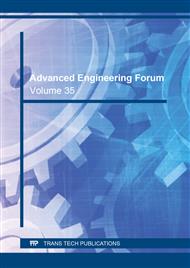[1]
C. Fröhlich and R. W. Brusa, Solar Radiation and Its Variation in Time,, Sol. Phys. 74, 209-215 (1981).
DOI: 10.1007/bf00151291
Google Scholar
[2]
C. Fröhlich and C. Wehrli, Spectral Distribution of Solar Irradiance from 25000 nm to 250 nm,, World Radiation Center, Davos, Switzerland, (1981).
Google Scholar
[3]
Solar Electromagnetic Radiation,, NASA SP-8005 (May 1971).
Google Scholar
[4]
Earth Albedo and Emitted Radiation,, NASA SP-8067 (July 1971).
Google Scholar
[5]
D. E Gluck, Space Vehicle Thermal Testing: Environments, Related Design and Analysis, Requirements, and Practice,, The Aerospace Corporation, Report No. TOR-86A(2902-08)-1, 27 September (1987).
Google Scholar
[6]
G. L. Stephens, G. G. Campbell, and T. H. Von der Haar, Earth Radiation Budgets,, J. Geophys. Res. 86 (20 October 1981).
Google Scholar
[7]
G. L. Smith, D. Rutan, and T. D. Bess, Atlas of Albedo and Absorbed Solar Radiation Derived from Nimbus 7 Earth Radiation Budget Data Set--November 1978 to October 1985,, NASA Ref. Pub. 1231, (1990).
Google Scholar
[8]
R. L. Collins, Albedo and Earthshine,, The Aerospace Corporation IOC 87.5462.4- 25, 27 April (1987).
Google Scholar
[9]
M. Donabedian, Thermal Uncertainty Margins for Cryogenic Sensor Systems,, The Aerospace Corporation, ATM 90(9975)-3, 21 November (1989).
Google Scholar
[10]
D. S. Glaister, Space Environment for Cryogenic Radiator,, The Aerospace Corporation, ATM No. 90(9975)-35, 3 May (1990).
Google Scholar
[11]
B. R. Barkstrom and G. L. Smith, The Earth Radiation Budget Experiment: Science and Implementation,, Rev. Geophys. 24. 3 79-3.
Google Scholar
[12]
B. R. Barkstrom, E. Harrison, G. Smith, R. Green, J. Kibler, R. Cess, and ERBE Science Team, Earth Radiation Budget Experiment (ERBE Archival and April 1985 Results)., Bull. Am. Meteorol. Soc. 70 (10), 1254-1262 (1989).
DOI: 10.1175/1520-0477(1989)070<1254:erbeaa>2.0.co;2
Google Scholar
[13]
T. D. Bess and G. L. Smith, Earth Radiation Budget: Results of Outgoing Longwave Radiation from Nimbus-7, NOAA-9, and ERBS Satellites,, J. Appl. Meteorol. 32 (5).
DOI: 10.1175/1520-0450(1993)032<0813:erbroo>2.0.co;2
Google Scholar
[14]
Natural Orbital Environment Criteria Guidelines for Use in Space Vehicle Development,, NASA Technical Memorandum 4527, June (1994).
Google Scholar
[15]
B. J. Anderson, C. G. Justus, and W. Batts, Guidelines for the Selection of Near- Earth Thermal Environment Parameters for Spacecraft Design,, NASA Technical Memorandum TM-2001-211221 (October 2001). 813-824 (1993).90 (1986).
Google Scholar
[16]
David G. Gilmore, Spacecraft Thermal Control Handbook: Fundamental technologies, American Institute of Aeronautics and Astronautics, Inc., 2002, Vol. 1.
Google Scholar
[17]
R. J. Duckett and C. S. Gilliland, Variable Anodic Thermal Control Coating on Aluminum, AIAA-83-1492, AIAA 18th Thermophysics Conference, (1983).
DOI: 10.2514/6.1983-1492
Google Scholar
[18]
E. I. Lin, J. W. Stultz, and R. T. Reeve, Test-Derived Effective Emittance for Cassini MLI Blankets and Heat Loss Characteristics in the Vicinity of Seams, AIAA paper 95-2015 (June 1995). (1 -3 June 1983).
DOI: 10.2514/6.1995-2015
Google Scholar
[19]
J. Doenecke, Survey and Evaluation of Multilayer Insulation Heat Transfer Measurements,, SAE paper 932117 (1993).
DOI: 10.4271/932117
Google Scholar
[20]
D. V. Hale, M. J. Hoover, and M. J. O'Neill, Phase Change Materials Handbook,, NASA Contractor Report CR-61363 (September 1971).
Google Scholar
[21]
NASA Technical paper 1074, "A Design Handbook for phase change thermal control and energy storage device,(1977).
Google Scholar
[22]
M. S. Busby and S. J. Mertesdorf, The Benefit of Phase Change Thermal Storage for Spacecraft Thermal Management,, AIAA-87-1482 (1987).
DOI: 10.2514/6.1987-1482
Google Scholar
[23]
W. R. Humphries and E. I. Griggs, A Design Handbook for Phase Change Thermal Control and Energy Storage Devices,, NASA Technical Paper 1074 (November 1977).
Google Scholar
[24]
Thornton, E.A.: Thermal Structures for Aerospace Applications (AIAA Education Series), AIAA, Arlington, V A, (1996).
Google Scholar
[25]
Sellers, J.J.: Understanding Space: An Introduction to Astronautics, McGraw-Hill, (1993).
Google Scholar
[26]
ESA: First ESAjESTEC Workshop on Thermal Protection Systems, ESA-WPP-053, (1996).
Google Scholar
[27]
Karam, R.D. and Zarchan P.: Satellite Thermal Control for Systems Engineers, part of proceedings for ESA-WPP-053 First ESA/ESTEC Workshop on Thermal Protection Systems, AIAA, Reston, V A, (1998).
Google Scholar
[28]
M. M. Finckenor and D. D. Dooling, Multilayer Insulation Material Guidelines, NASA/TP-1999-209263 (April 1998).
Google Scholar
[29]
Nakamura Y, Nishijo K, Murakami N, et al. Small Demonstration Satellite-4 (SDS-4): Development, Flgith Results, and Lessons Learned in JAXA's Microsatellite Project. (2013).
Google Scholar
[30]
Anil K. Maini, Varsha Agrawal, Satellite Technology: Principles and Applications, John Wiley & Sons, Jan-(2007).
Google Scholar
[31]
Aero-threads MLI brochure from 2018 Smallsat Conference, (2018).
Google Scholar
[32]
Anvari, A and Farhani, Foad and Niaki, Keyvan. (2009). Comparative Study on Space Qualified Paints Used for Thermal Control of a Small Satellite. Iranian Journal of Chemical Engineering. 6.
Google Scholar
[33]
Hengeveld D, Braun J, Groll E, Williams A. Review of Modern Spacecraft Thermal Control Technologies and Their Application to Next- Generation Buildings. 2010;(40).
Google Scholar


